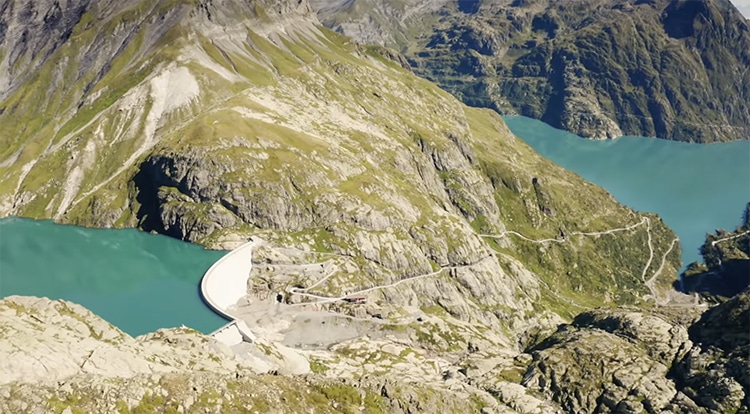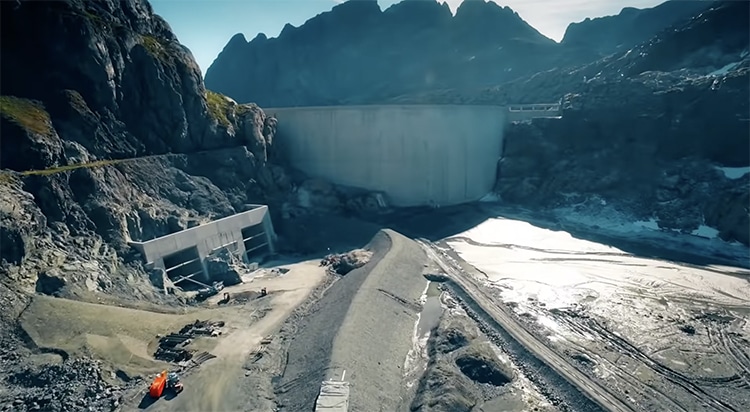The Complex Relationship and Looming Crisis Between Our Thirst For Water and Our Hunger for Energy
December 25th, 2022
Via MyModernMet, an article ona n enormous Swiss water battery project — known as Nant de Drance — that is at last operational:
Solar and wind energy are the future. But both of these renewable, sustainable energy sources are dependent on varying environmental conditions. Where does one store the extra energy produced by solar panels on a summer day or windmills churning as a breeze rips over the ocean? Traditional batteries require minerals that are dangerous and damaging to the Earth. While some researchers are pursuing experimental solutions, the “water battery” is a tried and true method for storing energy. An enormous Swiss water battery project—known as Nant de Drance—is at last operational. It is a glimpse into the future of energy storage.
For the past 14 years, construction crews have been working hard to complete this ambitious project. They began by hollowing out 11 miles of tunnels in the Swiss Alps connecting the reservoirs of Emosson and Vieux Emosson in Valais, Switzerland. Through these tunnels, they dragged building materials to construct an elegant arched dam to retain the upper body of water. Inside, they installed powerful turbines. After years of hard work, the system—Nant de Drance—is now operational. When in use to generate power, the turbines produce 900 MW of power, enough to power 900,000 homes.
So, how does the water battery work? When excess energy needs to be stored, that energy is used to pump water from the lower to the upper reservoir. This is like charging a battery. The water then remains at the top of the system until the energy is needed, where it can store 20 million kWh of energy. The water is then channeled back down, passing through the massive turbines. They spin to “harvest” the stored energy. Simple physics is therefore a powerful solution to the storage problems of renewable energy.
This technology has been used for centuries in Switzerland. You can also find water batteries in other countries, like the U.S. and China. Despite the technological leaps forward in other battery technology, the classic water battery might just be the best—and arguably most beautiful—solution to energy storage problems.
These two reservoirs in the Swiss Alps form a “water battery” which can store 20 million kWh of energy.
The “battery” can store excess energy produced during more active periods of wind and solar harvesting.
By releasing water from on high and channeling it through underground turbines, the energy can be released to meet higher demand.
This entry was posted on Sunday, December 25th, 2022 at 10:24 am and is filed under Uncategorized. You can follow any responses to this entry through the RSS 2.0 feed. Both comments and pings are currently closed.
Educated at Yale University (Bachelor of Arts - History) and Harvard (Master in Public Policy - International Development), Monty Simus has held a lifelong interest in environmental and conservation issues, primarily as they relate to freshwater scarcity, renewable energy, and national park policy. Working from a water-scarce base in Las Vegas with his wife and son, he is the founder of Water Politics, an organization dedicated to the identification and analysis of geopolitical water issues arising from the world’s growing and vast water deficits, and is also a co-founder of SmartMarkets, an eco-preneurial venture that applies web 2.0 technology and online social networking innovations to motivate energy & water conservation. He previously worked for an independent power producer in Central Asia; co-authored an article appearing in the Summer 2010 issue of the Tulane Environmental Law Journal, titled: “The Water Ethic: The Inexorable Birth Of A Certain Alienable Right”; and authored an article appearing in the inaugural issue of Johns Hopkins University's Global Water Magazine in July 2010 titled: “H2Own: The Water Ethic and an Equitable Market for the Exchange of Individual Water Efficiency Credits.”


